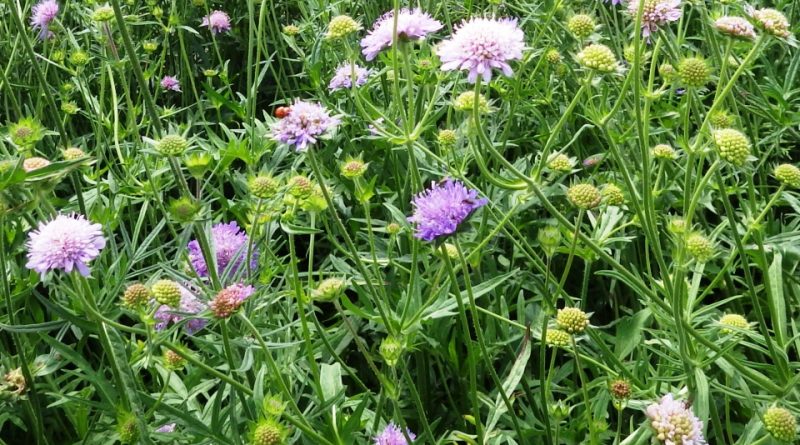Knautia arvensis
Knautia arvensis
The field scabious (Knautia arvensis (L.) Coulter) is a perennial herbaceous species belonging to the Dipsacaceae family.
Systematics –
From a systematic point of view it belongs to:
Eukaryota Domain,
Kingdom Plantae,
Spermatophyta superdivision,
Magnoliophyta Division,
Magnoliopsida class,
Subclass Asteridae,
Order Dipsacales,
Dipsacaceae family,
Genus Knautia,
K. Arvensis species.
Basionimo is the term:
– Scabiosa arvensis L;
The term is synonymous:
– Knautia calycina Auct ..
Etymology –
The term Knautia of the genus was dedicated to the German prelinnean botanists Christoph Knaut (1638-1694) and his brother Christian (1656-1716).
The specific epithet arvensis comes from arvum campo, arable land: arable land, a reference to the growing environment.
Geographic Distribution and Habitat –
The field scabious is a species with a vast Eurasian distribution and is present throughout Italy but with large gaps in the South.
Its habitat is that of grassy places, uncultivated areas and meadows-pastures, scrublands, hedges and clearings, from sea level to about 2000 m.
Description –
Knautia arvensis is a perennial (mostly biennial), herbaceous plant.
The stems are erect or ascending, slightly pubescent. The height of the plant varies from twenty to seventy centimeters (one meter maximum). It is a bushy, stoloniferous plant with a short rhizome.
Before flowering it shows a rosette of opposite leaves, slightly hairy greyish green. The petiolate basal leaves are whole or lobed, while the cauline ones are divided into several segments you see greyish.
From the rosette of leaves rise long stems, branched only at the top, bearing flat flower heads of violet pink, bluish violet and rarely white flowers. The dense flower heads of fragrant flowers are three to four centimeters wide and bloom from May to September. The flowers, individually, are formed by 4 lobes of different lengths, particularly long in the peripheral flowers of the head.
Pollination occurs through bees and butterflies.
The fruit is a cylindrical, close and hairy cypsela with a persistent calyx, 5-6 mm long, with 4 corners, crowned by fragile hairs.
Cultivation –
The field scabious is a plant that grows well even in partially shaded areas but for a copious and prolonged flowering it should be grown in bright and sunny places for many hours a day. In shady areas, flowering is sparse or absent. It tolerates cold and even very cold winter temperatures quite well.
From the pedological point of view, even if it develops quite well in common garden soil, it prefers a substrate rich in organic matter, loose and well drained.
It is a plant that grown in the ground is generally satisfied with rainwater but in periods of prolonged drought it is advisable to water it regularly. The plant can also be grown in pots where it should be watered, however, at least 3 times a week. In winter, the ambrette goes into vegetative rest and therefore watering must be suspended completely.
The multiplication is by seed or by division of the tufts.
The multiplication by seed is carried out in a warm seedbed at the end of winter and in the open ground towards the end of April.
In February it is sown in a cold greenhouse and the seedlings must be kept sheltered until the danger of night frosts is definitively averted.
From April onwards, sowing is carried out directly at home and subsequently the seedlings are thinned out at a distance of about 35-40 cm from each other. It is also possible to divide particularly vigorous tufts, placing the practiced portions directly in a single container.
Customs and Traditions –
Knautia arvensis is a plant that contains tannins; it is therefore a medicinal plant known since ancient times. It is said to have the property of purifying the blood, but it also seems to be effective against cold diseases (bronchitis, constipation and more). It is also considered for its diuretic and astringent properties.
It can be used in the kitchen for vegetable side dishes, but also for soups or omelettes. However, only the leaves collected before flowering are used.
Preparation Method –
The leaves of the field scabious are eaten above all before the flowers appear. Some flower petals, on the other hand, can be used as decoration for dishes.
The leaves can be used as cooked vegetables, in soups, in omelettes.
Guido Bissanti
Sources
– Acta Plantarum – Flora of the Italian Regions.
– Wikipedia, the free encyclopedia.
– Useful Tropical Plants Database.
– Conti F., Abbate G., Alessandrini A., Blasi C. (ed.), 2005. An annotated checklist of the Italian vascular flora, Palombi Editore.
– Pignatti S., 1982. Flora of Italy, Edagricole, Bologna.
– Treben M., 2000. Health from the Lord’s Pharmacy, Advice and experiences with medicinal herbs, Ennsthaler Editore.
Warning: Pharmaceutical applications and alimurgical uses are indicated for informational purposes only, they do not represent in any way a medical prescription; therefore no responsibility is taken for their use for curative, aesthetic or food purposes.


